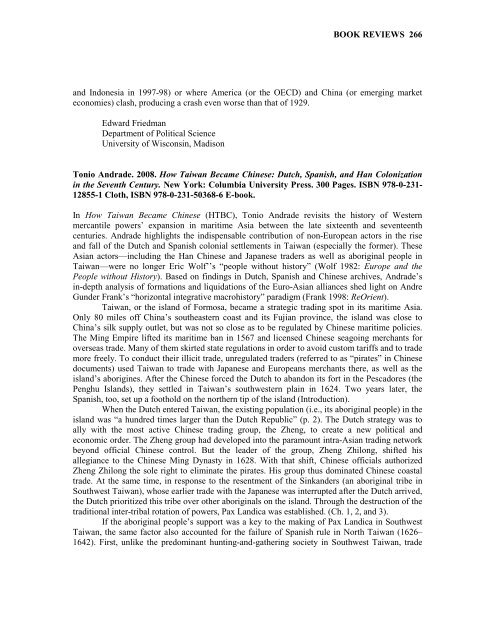Entire Volume 17 issue 1 - Journal of World-Systems Research ...
Entire Volume 17 issue 1 - Journal of World-Systems Research ...
Entire Volume 17 issue 1 - Journal of World-Systems Research ...
Create successful ePaper yourself
Turn your PDF publications into a flip-book with our unique Google optimized e-Paper software.
BOOK REVIEWS 266<br />
and Indonesia in 1997-98) or where America (or the OECD) and China (or emerging market<br />
economies) clash, producing a crash even worse than that <strong>of</strong> 1929.<br />
Edward Friedman<br />
Department <strong>of</strong> Political Science<br />
University <strong>of</strong> Wisconsin, Madison<br />
Tonio Andrade. 2008. How Taiwan Became Chinese: Dutch, Spanish, and Han Colonization<br />
in the Seventh Century. New York: Columbia University Press. 300 Pages. ISBN 978-0-231-<br />
12855-1 Cloth, ISBN 978-0-231-50368-6 E-book.<br />
In How Taiwan Became Chinese (HTBC), Tonio Andrade revisits the history <strong>of</strong> Western<br />
mercantile powers’ expansion in maritime Asia between the late sixteenth and seventeenth<br />
centuries. Andrade highlights the indispensable contribution <strong>of</strong> non-European actors in the rise<br />
and fall <strong>of</strong> the Dutch and Spanish colonial settlements in Taiwan (especially the former). These<br />
Asian actors—including the Han Chinese and Japanese traders as well as aboriginal people in<br />
Taiwan—were no longer Eric Wolf’’s “people without history” (Wolf 1982: Europe and the<br />
People without History). Based on findings in Dutch, Spanish and Chinese archives, Andrade’s<br />
in-depth analysis <strong>of</strong> formations and liquidations <strong>of</strong> the Euro-Asian alliances shed light on Andre<br />
Gunder Frank’s “horizontal integrative macrohistory” paradigm (Frank 1998: ReOrient).<br />
Taiwan, or the island <strong>of</strong> Formosa, became a strategic trading spot in its maritime Asia.<br />
Only 80 miles <strong>of</strong>f China’s southeastern coast and its Fujian province, the island was close to<br />
China’s silk supply outlet, but was not so close as to be regulated by Chinese maritime policies.<br />
The Ming Empire lifted its maritime ban in 1567 and licensed Chinese seagoing merchants for<br />
overseas trade. Many <strong>of</strong> them skirted state regulations in order to avoid custom tariffs and to trade<br />
more freely. To conduct their illicit trade, unregulated traders (referred to as “pirates” in Chinese<br />
documents) used Taiwan to trade with Japanese and Europeans merchants there, as well as the<br />
island’s aborigines. After the Chinese forced the Dutch to abandon its fort in the Pescadores (the<br />
Penghu Islands), they settled in Taiwan’s southwestern plain in 1624. Two years later, the<br />
Spanish, too, set up a foothold on the northern tip <strong>of</strong> the island (Introduction).<br />
When the Dutch entered Taiwan, the existing population (i.e., its aboriginal people) in the<br />
island was “a hundred times larger than the Dutch Republic” (p. 2). The Dutch strategy was to<br />
ally with the most active Chinese trading group, the Zheng, to create a new political and<br />
economic order. The Zheng group had developed into the paramount intra-Asian trading network<br />
beyond <strong>of</strong>ficial Chinese control. But the leader <strong>of</strong> the group, Zheng Zhilong, shifted his<br />
allegiance to the Chinese Ming Dynasty in 1628. With that shift, Chinese <strong>of</strong>ficials authorized<br />
Zheng Zhilong the sole right to eliminate the pirates. His group thus dominated Chinese coastal<br />
trade. At the same time, in response to the resentment <strong>of</strong> the Sinkanders (an aboriginal tribe in<br />
Southwest Taiwan), whose earlier trade with the Japanese was interrupted after the Dutch arrived,<br />
the Dutch prioritized this tribe over other aboriginals on the island. Through the destruction <strong>of</strong> the<br />
traditional inter-tribal rotation <strong>of</strong> powers, Pax Landica was established. (Ch. 1, 2, and 3).<br />
If the aboriginal people’s support was a key to the making <strong>of</strong> Pax Landica in Southwest<br />
Taiwan, the same factor also accounted for the failure <strong>of</strong> Spanish rule in North Taiwan (1626–<br />
1642). First, unlike the predominant hunting-and-gathering society in Southwest Taiwan, trade





